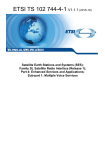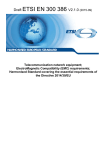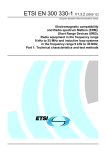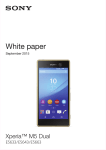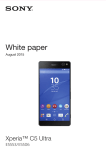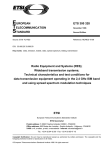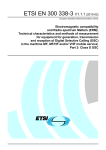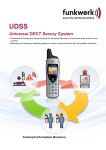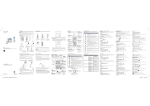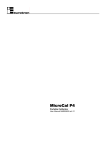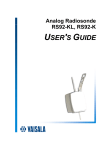Download EN 302 054-1 - V1.2.0 - Meteorological Aids (Met Aids
Transcript
Draft ETSI EN 302 054-1 V1.2.0 (2015-06) EUROPEAN STANDARD Meteorological Aids (Met Aids); Radiosondes to be used in the 400,15 MHz to 406 MHz frequency range with power levels ranging up to 200 mW; Part 1: Technical characteristics and test methods 2 Draft ETSI EN 302 054-1 V1.2.0 (2015-06) Reference REN/ERM-JTFEA-25 Keywords radio, short range, testing, UHF ETSI 650 Route des Lucioles F-06921 Sophia Antipolis Cedex - FRANCE Tel.: +33 4 92 94 42 00 Fax: +33 4 93 65 47 16 Siret N° 348 623 562 00017 - NAF 742 C Association à but non lucratif enregistrée à la Sous-Préfecture de Grasse (06) N° 7803/88 Important notice The present document can be downloaded from: http://www.etsi.org/standards-search The present document may be made available in electronic versions and/or in print. The content of any electronic and/or print versions of the present document shall not be modified without the prior written authorization of ETSI. In case of any existing or perceived difference in contents between such versions and/or in print, the only prevailing document is the print of the Portable Document Format (PDF) version kept on a specific network drive within ETSI Secretariat. Users of the present document should be aware that the document may be subject to revision or change of status. Information on the current status of this and other ETSI documents is available at http://portal.etsi.org/tb/status/status.asp If you find errors in the present document, please send your comment to one of the following services: https://portal.etsi.org/People/CommiteeSupportStaff.aspx Copyright Notification No part may be reproduced or utilized in any form or by any means, electronic or mechanical, including photocopying and microfilm except as authorized by written permission of ETSI. The content of the PDF version shall not be modified without the written authorization of ETSI. The copyright and the foregoing restriction extend to reproduction in all media. © European Telecommunications Standards Institute 2015. All rights reserved. DECTTM, PLUGTESTSTM, UMTSTM and the ETSI logo are Trade Marks of ETSI registered for the benefit of its Members. 3GPPTM and LTE™ are Trade Marks of ETSI registered for the benefit of its Members and of the 3GPP Organizational Partners. GSM® and the GSM logo are Trade Marks registered and owned by the GSM Association. ETSI 3 Draft ETSI EN 302 054-1 V1.2.0 (2015-06) Contents Intellectual Property Rights................................................................................................................................ 5 Foreword ............................................................................................................................................................ 5 Modal verbs terminology ................................................................................................................................... 5 Introduction ........................................................................................................................................................ 6 1 Scope ........................................................................................................................................................ 7 2 References ................................................................................................................................................ 7 2.1 2.2 3 3.1 3.2 3.3 4 4.1 4.1.1 4.1.2 4.1.3 4.1.4 4.1.4.1 4.1.4.2 4.2 4.2.1 4.2.1.1 4.2.1.2 4.2.2 5 5.1 5.2 5.2.1 5.2.2 5.3 5.3.1 5.3.2 5.4 5.4.1 5.4.2 5.4.3 5.4.4 5.4.4.1 5.4.4.2 6 6.1 6.2 6.3 6.4 6.5 6.6 7 7.1 7.2 7.2.1 Normative references ......................................................................................................................................... 7 Informative references ....................................................................................................................................... 7 Definitions, symbols and abbreviations ................................................................................................... 7 Definitions ......................................................................................................................................................... 7 Symbols ............................................................................................................................................................. 8 Abbreviations ..................................................................................................................................................... 8 Technical requirement specifications....................................................................................................... 8 Presentation of equipment for testing purposes ................................................................................................. 8 General Considerations ................................................................................................................................ 8 Choice of model for testing .......................................................................................................................... 8 Testing of equipment with alternative power levels ..................................................................................... 9 Testing of equipment that does not have an external 50 Ω RF connector (integral antenna equipment) .................................................................................................................................................... 9 Equipment with an internal permanent or temporary antenna connector ............................................... 9 Equipment with an internal permanent antenna ...................................................................................... 9 Mechanical and electrical design ....................................................................................................................... 9 Marking (equipment identification).............................................................................................................. 9 Equipment identification ........................................................................................................................ 9 Marking .................................................................................................................................................. 9 Auxiliary test equipment .............................................................................................................................. 9 Test conditions, power sources and ambient temperatures ...................................................................... 9 Normal and extreme test conditions ................................................................................................................... 9 Test power source ............................................................................................................................................ 10 External test power source.......................................................................................................................... 10 Internal test power source ........................................................................................................................... 10 Normal test conditions ..................................................................................................................................... 10 Normal temperature and humidity.............................................................................................................. 10 Normal test power source ........................................................................................................................... 10 Extreme test conditions .................................................................................................................................... 10 General ....................................................................................................................................................... 10 Procedure for tests at extreme conditions ................................................................................................... 11 Special Radiosondes ................................................................................................................................... 11 Extreme test source voltages ...................................................................................................................... 11 Power sources using batteries ............................................................................................................... 11 Other power sources ............................................................................................................................. 11 General conditions ................................................................................................................................. 12 Normal test signals and test modulation .......................................................................................................... 12 Artificial antenna ............................................................................................................................................. 12 Test fixture ....................................................................................................................................................... 12 Test sites and general arrangements for radiated measurements...................................................................... 12 Modes of operation of the transmitter .............................................................................................................. 12 Measuring receiver........................................................................................................................................... 13 Methods of measurement and limits for transmitter parameters ............................................................ 13 General ............................................................................................................................................................. 13 Frequency error ................................................................................................................................................ 13 Definitions .................................................................................................................................................. 13 ETSI 4 7.2.2 7.2.3 7.3 7.3.1 7.3.2 7.3.3 7.4 7.4.1 7.4.2 7.4.3 7.5 7.5.1 7.5.2 7.5.3 7.6 7.6.1 7.6.2 7.6.2.0 7.6.2.1 7.6.2.2 7.6.2.3 7.6.3 7.7 7.7.1 7.7.2 7.7.3 Draft ETSI EN 302 054-1 V1.2.0 (2015-06) Method of measurement ............................................................................................................................. 13 Limit ........................................................................................................................................................... 13 Carrier power (conducted) ............................................................................................................................... 13 Definition ................................................................................................................................................... 13 Method of measurement ............................................................................................................................. 14 Limits ......................................................................................................................................................... 14 Effective radiated power .................................................................................................................................. 14 Definition ................................................................................................................................................... 14 Methods of measurement ........................................................................................................................... 14 Limit ........................................................................................................................................................... 15 Modulation bandwidth ..................................................................................................................................... 15 Definition ................................................................................................................................................... 15 Method of measurement ............................................................................................................................. 15 Limits ......................................................................................................................................................... 15 Spurious emissions........................................................................................................................................... 16 Definition ................................................................................................................................................... 16 Methods of measurement ........................................................................................................................... 16 General requirement ............................................................................................................................. 16 Method of measuring the power level in a specified load, clause 7.6.2.0 a) i) ..................................... 16 Method of measuring the effective radiated power, clause 7.6.2.0 a) ii) .............................................. 17 Method of measuring the effective radiated power, clause 7.6.2.0 b) .................................................. 17 Limits ......................................................................................................................................................... 18 Frequency stability under low voltage conditions ............................................................................................ 18 Definition ................................................................................................................................................... 18 Method of measurement ............................................................................................................................. 18 Limits ......................................................................................................................................................... 18 History .............................................................................................................................................................. 19 ETSI 5 Draft ETSI EN 302 054-1 V1.2.0 (2015-06) Intellectual Property Rights IPRs essential or potentially essential to the present document may have been declared to ETSI. The information pertaining to these essential IPRs, if any, is publicly available for ETSI members and non-members, and can be found in ETSI SR 000 314: "Intellectual Property Rights (IPRs); Essential, or potentially Essential, IPRs notified to ETSI in respect of ETSI standards", which is available from the ETSI Secretariat. Latest updates are available on the ETSI Web server (http://ipr.etsi.org). Pursuant to the ETSI IPR Policy, no investigation, including IPR searches, has been carried out by ETSI. No guarantee can be given as to the existence of other IPRs not referenced in ETSI SR 000 314 (or the updates on the ETSI Web server) which are, or may be, or may become, essential to the present document. Foreword This draft European Standard (EN) has been produced by ETSI Technical Committee Electromagnetic compatibility and Radio spectrum Matters (ERM), and is now submitted for the combined Public Enquiry and Vote phase of the ETSI standards EN Approval Procedure. For non EU countries the present document may be used for regulatory (Type Approval) purposes. The present document is part 1 of a multi-part deliverable covering digitally modulated Radiosonde transmitters in the Meteorological Aids frequency band from 400,15 MHz to 406 MHz, as identified below: Part 1: "Technical characteristics and test methods"; Part 2: "Harmonised Standard covering the essential requirements of article 3.2 of the Directive 2014/53/EU". Proposed national transposition dates Date of latest announcement of this EN (doa): 3 months after ETSI publication Date of latest publication of new National Standard or endorsement of this EN (dop/e): 6 months after doa Date of withdrawal of any conflicting National Standard (dow): 18 months after doa Modal verbs terminology In the present document "shall", "shall not", "should", "should not", "may", "need not", "will", "will not", "can" and "cannot" are to be interpreted as described in clause 3.2 of the ETSI Drafting Rules (Verbal forms for the expression of provisions). "must" and "must not" are NOT allowed in ETSI deliverables except when used in direct citation. ETSI 6 Draft ETSI EN 302 054-1 V1.2.0 (2015-06) Introduction Meteorological aids, Radiosondes, are light weight, disposable precision measurement instruments mainly used for in situ upper air measurements of meteorological variables (pressure, temperature, relative humidity, wind speed and direction) in the atmosphere up to an altitude of 36 km. The measurements are vital to international weather forecasting capability (and hence severe weather warning services for the public involving protection of life and property). The Radiosonde systems provide simultaneous measurements of the vertical profile of temperature, relative humidity as well as wind speed and direction. The variation of these meteorological variables in the vertical contains the majority of the critical information for weather forecasting. These systems are the only meteorological observing systems able to regularly provide the vertical resolution that meteorologists need for all five variables. Typically the Radiosonde observations are produced by Radiosondes measuring atmosphere for approximately 2 hours and carried by ascending balloons launched from land stations or ships. Radiosonde observations are carried out routinely by almost all countries, two to four times a day. The observation data is then circulated immediately to all other countries within a few hours via the WMO (World Meteorological Organization) Global Telecommunications System (GTS). The observing systems and data dissemination are all organized under the framework of the World Weather Watch Programme of WMO. The observation stations are required, worldwide, at a horizontal spacing of less than or equal to 250 km, during the first decade of the twenty-first century, with a frequency of observation of from one to four times per day. Remotely sensed measurements from satellites do not have the vertical resolution available from Radiosondes. Successful derivation of vertical temperature structure from these satellite measurements usually requires a computation initialized either directly from Radiosonde statistics or from the numerical weather forecast itself. In the latter case, the Radiosonde measurements ensure that the vertical structure in these forecasts remains accurate and stable with time. In addition, the Radiosonde measurements are used to calibrate satellite observations by a variety of techniques. Radiosonde observations are thus seen to remain absolutely necessary for meteorological operations for the foreseeable future. Other applications, independent of the main civilian meteorological organizations include environmental pollution, hydrology, radioactivity in the free atmosphere, significant weather phenomena (e.g. winter storms, thunderstorms, etc.) and investigation of a range of physical and chemical properties of the atmosphere. About 150 000 Radiosondes are annually used in Europe, about 90 % of them are in 403 MHz band. This use is not decreasing with time, since with modern automation it is now much easier to successfully operate systems without highly skilled operators and a large amount of supporting equipment. The Radiosondes use unidirectional transmission on two frequency bands: 403 MHz band covers primary and coprimary allocations from 400,15 MHz to 406 MHz and 1 680 MHz band from 1 668,4 MHz to 1 690 MHz. The 403 MHz Radiosonde technology applies GNSS (Global Navigation Satellite Systems) for wind measurement, whereas the 1 680 MHz systems may base the wind measurement on balloon tracking with a Radio Direction Finding antenna. Because the 403 MHz wind measurement depends on the availability of the GNSS signals, many operators do not consider this technology secure enough for critical applications (e.g. defence and national security), and consequently prefer 1 680 MHz systems. National regulatory conditions may apply regarding the, channel/frequency separations, and the inclusion of an automatic transmitter shut-off feature as a condition of an individual or general license, or, as a condition of use under license exemption. The automatic transmitter shut-off facility of the Radiosonde may be based on elapsed time from the beginning of the sounding, or atmospheric pressure or height measured by the Radiosonde. ETSI 7 1 Draft ETSI EN 302 054-1 V1.2.0 (2015-06) Scope The present document defines the technical requirements for transmitters used in Radiosondes operating in the range from 400,15 MHz to 406 MHz and with power levels ranging up to 200 mW. 2 References 2.1 Normative references References are either specific (identified by date of publication and/or edition number or version number) or non-specific. For specific references, only the cited version applies. For non-specific references, the latest version of the reference document (including any amendments) applies. Referenced documents which are not found to be publicly available in the expected location might be found at http://docbox.etsi.org/Reference. NOTE: While any hyperlinks included in this clause were valid at the time of publication, ETSI cannot guarantee their long term validity. The following referenced documents are necessary for the application of the present document. [1] CISPR 16-1-1: "Specification for radio disturbance and immunity measuring apparatus and methods - Part 1-1: Radio disturbance and immunity measuring apparatus - Measuring apparatus". [2] ETSI TS 103 052 (V1.1.1) (2011-03): "Electromagnetic compatibility and Radio spectrum Matters (ERM); Radiated measurement methods and general arrangements for test sites up to 100 GHz". [3] ETSI EN 300 220-1 (V2.4.1) (2012-05): "Electromagnetic compatibility and Radio spectrum Matters (ERM); Short Range Devices (SRD); Radio equipment to be used in the 25 MHz to 1 000 MHz frequency range with power levels ranging up to 500 mW; Part 1: Technical characteristics and test methods". 2.2 Informative references References are either specific (identified by date of publication and/or edition number or version number) or non-specific. For specific references, only the cited version applies. For non-specific references, the latest version of the reference document (including any amendments) applies. NOTE: While any hyperlinks included in this clause were valid at the time of publication, ETSI cannot guarantee their long term validity. The following referenced documents are not necessary for the application of the present document but they assist the user with regard to a particular subject area. Not applicable. 3 Definitions, symbols and abbreviations 3.1 Definitions For the purposes of the present document, the following terms and definitions apply: conducted measurements: measurements which are made using a direct 50 Ω connection to the equipment under test dedicated antenna: removable antenna supplied and type tested with the radio equipment, designed as an indispensable part of the equipment integral antenna: permanent fixed antenna, which may be built-in, designed as an indispensable part of the equipment radiated measurements: measurements which involve the absolute measurement of a radiated field ETSI 8 Draft ETSI EN 302 054-1 V1.2.0 (2015-06) telemetry: use of radio communication for indicating or recording data at a distance 3.2 Symbols For the purposes of the present document, the following symbols apply: dB E ° C hPa %RH λ 3.3 decibel Field strength Temperature in degrees Celsius Atmospheric pressure in hecto Pascal Air relative humidity in percentage Wavelength Abbreviations For the purposes of the present document, the following abbreviations apply: CISPR EU EUT FAR GNSS GTS ICAO ITU-R MSS RF RH VSWR WMO International Special Committee on Radio Interference European Union Equipment Under Test Fully Anechoic Room Global Navigation Satellite Systems Global Telecommunications System International Civil Aviation Organization International Telecommunication Union - Radiocommunication Sector Mobile Satellite Service Radio Frequency Relative Humidity Voltage Standing Wave Ratio World Meteorological Organization 4 Technical requirement specifications 4.1 Presentation of equipment for testing purposes 4.1.1 General Considerations Each equipment submitted for testing shall fulfil the requirements of the present document on all frequencies over which it is intended to operate. Testing shall be carried out on the highest and lowest frequencies within the equipment's intended operating range. If an equipment is designed to operate with different carrier powers, measurement of each transmitter parameter shall be performed at the highest power level at which the transmitter is intended to operate. To simplify and harmonize the testing procedures between the different testing laboratories, measurements shall be performed, according to the present document. 4.1.2 Choice of model for testing The manufacturer shall provide one or more samples of the equipment, as appropriate, for testing. If an equipment has several optional features, considered not to affect the RF parameters then tests need only be performed on the equipment configured with that combination of features considered to be the most complex, as proposed by the manufacturer and agreed by the test laboratory. Where practicable, equipment offered for testing shall provide a 50 Ω connector for conducted RF power measurements. In the case of integral antenna equipment, if the equipment does not have an internal permanent 50 Ω connector then it is permissible to supply a second sample of the equipment with a temporary 50 Ω antenna connector fitted to facilitate testing. ETSI 9 4.1.3 Draft ETSI EN 302 054-1 V1.2.0 (2015-06) Testing of equipment with alternative power levels If a family of equipment has alternative output power levels provided by the use of separate power modules or add on stages, then each module or add on stage shall be tested in combination with the equipment. The necessary samples and tests shall be proposed by the manufacturer and/or test laboratory and shall be agreed with the Administration(s), based on the requirements of clause 4.1. 4.1.4 4.1.4.1 Testing of equipment that does not have an external 50 Ω RF connector (integral antenna equipment) Equipment with an internal permanent or temporary antenna connector The means to access and/or implement the internal permanent or temporary antenna connector shall be stated by the manufacturer and the access method shall be recorded in the test report. No connection shall be made to any internal permanent or temporary antenna connector during the performance of radiated emissions measurements. 4.1.4.2 Equipment with an internal permanent antenna Manufacturer shall state and describe the method to connect test equipment to antenna port and this method shall be recorded in the test report. 4.2 Mechanical and electrical design 4.2.1 Marking (equipment identification) 4.2.1.1 Equipment identification The marking shall include as a minimum: • the name of the manufacturer or his trademark; • the type designation. 4.2.1.2 Marking The equipment shall be marked in a visible place, unless the equipment is too small to carry the marking, This marking shall be legible and durable. Relevant information shall be provided in the user manual. 4.2.2 Auxiliary test equipment All necessary auxiliary test equipment and set-up information shall accompany the EUT, when it is submitted for testing. 5 Test conditions, power sources and ambient temperatures 5.1 Normal and extreme test conditions Testing shall be performed under normal test conditions, and also, where stated, under extreme test conditions. The test conditions and procedures shall be as specified in clauses 5.2 to 5.4. ETSI 10 5.2 Test power source 5.2.1 External test power source Draft ETSI EN 302 054-1 V1.2.0 (2015-06) During tests, except radiated emission tests, the power source of the equipment shall be replaced by an external test power source capable of producing normal and extreme test voltages as specified in clauses 5.3.2 and 5.4.4. The internal impedance of the external test power source shall be low enough for its effect on the test results to be negligible. For the purpose of the tests, the voltage of the external test power source shall be measured. The external test power source shall be suitably de-coupled and applied as close to the equipment battery terminals as practicable. During tests, the external test power source voltages shall be within a tolerance < ±1 % relative to the voltage at the beginning of each test. 5.2.2 Internal test power source During normal operation (in flight) Radiosondes use only internal power source. For radiated measurements internal power source with adequate capacity high enough capacity to carry on the planned test without interruptions shall be used. The internal power source used should shall be as supplied or recommended by the manufacturer. At the end of each test the internal power source voltage should shall be verified to be within the range specified for the EUT. 5.3 Normal test conditions 5.3.1 Normal temperature and humidity The normal temperature and humidity conditions for tests shall be any combination of temperature and humidity within the ranges stated below, unless it is impracticable to carry out tests under these conditions. Any deviation from these ranges shall be recorded. - temperature: +15 °C to +35 °C; - relative humidity: 20 % RH to 75 % RH. When it is impracticable to carry out tests under these conditions, a note to this effect stating the ambient temperature and relative humidity during the tests, shall be recorded and stated. 5.3.2 Normal test power source During testing normal test voltage shall be within the range specified for the EUT and values shall be recorded and stated in the test report. 5.4 Extreme test conditions 5.4.1 General Tests at extreme conditions simulate the extreme atmospheric conditions which apply to the Radiosondes in normal operations. The atmospheric model, ICAO Standard Atmosphere, gives -56,5 °C as lower extreme temperature (see table 1). Table 1: Extreme atmospheric conditions Upper extreme temperature: Pressure: corresponding earth surface conditions Relative humidity: Note the reading Lower extreme temperature: Pressure: corresponding to about 16 km altitude Relative humidity: Note the reading ETSI +55 °C ±3 °C 980 hPa ±30 hPa Non condensing -56,5 °C ±3 °C 100 hPa ±30 hPa Non condensing 11 5.4.2 Draft ETSI EN 302 054-1 V1.2.0 (2015-06) Procedure for tests at extreme conditions Radiosondes are designed either for burst or continuous transmit modes. Thermally the difference between the modes is negligible, hence the test procedure is the same for all types of radiosondes. Before measurements are made, the EUT shall have reached thermal balance in the test chamber. The EUT shall be switched off during the temperature stabilizing period. Radiosondes typically have good or very good thermal insulation. If the thermal balance is not checked by measurements, a temperature stabilizing period of at least two hours, or such period as may be decided by the test laboratory, shall be allowed. The sequence of measurements shall be chosen, and the humidity content in the test chamber shall be controlled so that excessive condensation does not occur. Also a heat producing element (e.g. water activated battery) may be included in the normal use configuration, consequently the internal temperature, where the transmitter stays in normal use may be higher than the ambient temperature given in table 1: - for tests at the upper extreme temperature (table 1), the EUT shall be placed in the test chamber and left until thermal balance is attained. The EUT shall then be switched on in the transmit condition for a period of 15 minutes, after which the EUT shall meet the specified requirements; - for tests at the lower extreme temperatures (table 1), the EUT shall be left in the test chamber until thermal balance is attained, then switched on for a period of one minute after which the EUT shall meet the specified requirements. In case the internal temperature at the lower extreme temperature is known, the manufacturer shall state what is the true transmitter temperature during the normal use in conditions given in table 1. The stated true temperature shall then be used as the lower extreme temperature during the test and the temperature recorded in the test report. 5.4.3 Special Radiosondes Special Radiosondes, which are used for low altitude profiling (less than 100 hPa), may not be intended to operate in lower extreme temperature given in table 1, consequently the extreme conditions testing shall be agreed upon based on the intended application profile specified by the manufacturer of the EUT. 5.4.4 Extreme test source voltages 5.4.4.1 Power sources using batteries The lower extreme test voltages for equipment with power sources using batteries will be as follows: • for equipment with a battery indicator, the end point voltage shall be as indicated; • for equipment without a battery indicator, the following end point voltage shall be used: - for the Leclanché or the lithium type of battery: 0,85 multiplied by the nominal voltage of the battery; - for the nickel-cadmium type of battery: 0,9 multiplied by the nominal voltage of the battery; - for other types of battery, the equipment manufacturer shall declare the lower extreme test voltage for the discharged condition. The high end of nominal voltage is considered to be the upper extreme test voltage in this case. 5.4.4.2 Other power sources For equipment using other power sources, or capable of being operated from a variety of power sources, the extreme test voltages shall be those agreed at the time of test and should be recorded in the test report. ETSI 12 Draft ETSI EN 302 054-1 V1.2.0 (2015-06) 6 General conditions 6.1 Normal test signals and test modulation Modulation test signals only apply to products with an external modulation connector. For equipment without an external modulation connector, normal operating modulation shall be used in all tests with modulation. 6.2 Artificial antenna Where applicable, tests shall be carried out using an artificial antenna which shall be a substantially non-reactive non-radiating load with a 50 Ω connected to the antenna connector. The Voltage Standing Wave Ratio (VSWR) at the 50 Ω connector shall not be greater than 1,2: 1 over the frequency range of the measurement. 6.3 Test fixture With equipment intended for use with an integral antenna, and not equipped with a 50 Ω RF output connector, the manufacturer may supply a test fixture. This test fixture is a radio frequency coupling device for coupling the integral antenna to a 50 Ω radio frequency terminal at the working frequencies of the equipment under test. This allows certain measurements to be performed using conducted measuring methods, however, use of test fixture provides only relative measurement results. In addition, the test fixture shall provide, where applicable: - a connection to an external power supply; - a connection to a data interface. Test fixture properties and validation shall be as specified in the clause 6.3 of ETSI EN 300 220-1 [3]. 6.4 Test sites and general arrangements for radiated measurements Radiated measurement test sites and general arrangements shall be as specified in the clause 5 of ETSI TS 103 052 [2]. 6.5 Modes of operation of the transmitter For practical reasons, measurements shall be performed only at the highest power level at which the transmitter is intended to operate. The measurement shall be performed preferably in the absence of modulation. When it is not possible to measure it in the absence of modulation, this fact shall be stated in test reports. The transmitter shall be set in continuous transmission mode. If this is not possible, the measurements shall be carried out in a period shorter than the duration of the transmitted burst. It may be necessary to extend the duration of the burst. The transmitter shall be connected to an artificial antenna and the power delivered to this artificial antenna shall be measured. The equivalent isotropically radiated power is then calculated from the measured value, the known antenna gain, relative to an isotropic antenna, and if applicable, any losses due to cables and connectors in the measurement system. ETSI 13 6.6 Draft ETSI EN 302 054-1 V1.2.0 (2015-06) Measuring receiver The term measuring receiver refers to either a selective voltmeter or a spectrum analyser. The bandwidth of the measuring receiver shall be as given in table 2. Table 2 Frequency being measured: f f < 150 kHz 150 kHz ≤ f < 25 MHz 25 MHz ≤ f < 1 000 MHz 1 000 MHz ≤ f Measuring receiver bandwidth (6 dB) 200 Hz or 9 kHz or 120 kHz or Spectrum analyser bandwidth (3 dB) 1 kHz 10 kHz 100 kHz 1 MHz 7 Methods of measurement and limits for transmitter parameters 7.1 General Where the transmitter is designed with an adjustable carrier power, then all transmitter parameters shall be measured using the highest power level, as declared by the manufacturer. If the EUT is supplied with both a permanent external 50 Ω RF connector and a dedicated or integral antenna, then full tests shall be carried out using the external connector. In addition, the following tests shall be carried out with the dedicated or integral antenna: - effective radiated power (radiated) (see clause 7.4); - spurious emissions (see clause 7.6). The submitted EUT shall fulfil the requirements of the stated measurement. 7.2 Frequency error 7.2.1 Definitions The frequency error of the transmitter is the difference between the measured unmodulated carrier frequency and the nominal frequency as stated by the manufacturer under normal and extreme conditions (see clauses 5.3 and 5.4). 7.2.2 Method of measurement The carrier frequency shall be measured with the transmitter connected to an artificial antenna. A transmitter without a 50 Ω output connector may be placed in the test fixture (see clause 6.3) connected to an artificial antenna. The measurement shall be made under normal test conditions (see clause 5.3) and extreme test conditions (see clause 5.4) (extreme temperature and supply voltage simultaneously). If the EUT is not capable of producing an unmodulated carrier, then the frequency error shall be measured using the modulated carrier. 7.2.3 Limit The frequency error or drift shall not exceed ±20 kHz (corresponds to ±50 ppm @ 403 MHz). 7.3 Carrier power (conducted) 7.3.1 Definition The carrier power is the average power delivered to the artificial antenna (see clause 6.2) during one radio frequency cycle in the absence of modulation. ETSI 14 7.3.2 Draft ETSI EN 302 054-1 V1.2.0 (2015-06) Method of measurement This method applies only to EUT with an antenna connector. These measurements shall be performed at the highest power level at which the transmitter is intended to operate The transmitter shall be connected to an artificial antenna (see clause 6.2) and the carrier or mean power delivered to this artificial antenna shall be measured under normal test conditions (see clause 5.3) and extreme test conditions as specified in clause 5.4 (extreme temperature and supply voltage simultaneously). In the case of pulse modulation equipment where it is not possible to make the measurement in the absence of modulation, the measurement shall be carried out by the use of a measuring receiver with bandwidth as stated in clause 6.6 and peak detector set in accordance with the specification of CISPR 16-1-1 [1] section one for the bands C and D. 7.3.3 Limits Under normal and extreme test conditions, the carrier output power (conducted) shall not exceed 200 mW. 7.4 Effective radiated power 7.4.1 Definition The effective radiated power is the power radiated in the direction of the maximum level under specified conditions of measurements in the absence of modulation. 7.4.2 Methods of measurement This method applies to equipment with an integral antenna and to equipment supplied with a dedicated antenna. These measurements shall be performed at the highest power level at which the transmitter is intended to operate. The measurement shall be carried out under normal test conditions only. On a test site, selected from ETSI TS 103 052 [2], the EUT shall be placed at the specified height on a support, and in the orientation closest to normal use as declared by the manufacturer. The test antenna shall be oriented initially for vertical polarization and shall be chosen to correspond to the frequency of the transmitter. The output of the test antenna shall be connected to the measuring receiver. If possible, the transmitter shall be switched on without modulation. The measuring receiver shall be tuned to the frequency of the transmitter under test. In case of pulse modulation equipment where it is not possible to make the measurement in the absence of modulation, the measurement shall be carried out by the use of a measuring receiver with bandwidth as stated in clause 6.6 and peak detector shall be set in accordance with the specification of CISPR 16-1-1 [1], section one for the bands C and D. The test antenna shall be raised and lowered through the specified range of height until the measuring receiver detects a maximum signal level. The transmitter shall then be rotated through 360° in the horizontal plane, until the measuring receiver detects the maximum signal level. The test antenna shall be raised and lowered again through the specified range of height until the measuring receiver detects a maximum signal level. The transmitter shall be replaced by a substitution antenna as specified in the clause 5.3.2 of ETSI TS 103 052 [2] The substitution antenna shall be orientated for vertical polarization and the length of the substitution antenna shall be adjusted to correspond to the frequency of the transmitter. The substitution antenna shall be connected to a calibrated signal generator. ETSI 15 Draft ETSI EN 302 054-1 V1.2.0 (2015-06) If necessary, the input attenuator setting of the measuring receiver shall be adjusted in order to increase the sensitivity of the measuring receiver. The test antenna shall be raised and lowered through the specified range of height to ensure that the maximum signal is received. The input signal to the substitution antenna shall be adjusted to the level that produces a level detected by the measuring receiver, that is equal to the level noted while the transmitter radiated power was measured, corrected for the change of input attenuator setting of the measuring receiver. The input level to the substitution antenna shall be recorded as power level, corrected for any change of input attenuator setting of the measuring receiver. The measurement shall be repeated with the test antenna and the substitution antenna orientated for horizontal polarization. The measure of the effective radiated power is the larger of the two levels recorded at the input to the substitution antenna, corrected for gain of the substitution antenna if necessary. 7.4.3 Limit The effective radiated power shall not exceed 200 mW. 7.5 Modulation bandwidth 7.5.1 Definition The range of modulation bandwidth includes all associated side bands above the appropriate spurious level and the frequency error or drift under extreme test conditions. The requirement is that the emission limits are met under both normal and extreme conditions. Radiosondes do not have channel assignments. Table 3 suggests that 200 kHz is required to provide needed protection from interference in the case another Radiosonde is in the vicinity of the receiver, and the Radiosonde to be received is at long distance (up to 350 km). 7.5.2 Method of measurement If the tests in this section are conducted under extreme conditions then the frequency error tests in clause 7.2 may be omitted. If the tests are conducted under normal conditions then the upper and lower frequency error results obtained in clause 7.2 shall be added and subtracted to each frequency measurement obtained in these tests. In case of EUT with integral antenna, the equipment shall be placed in the test fixture (see clause 6.3). The RF output of the EUT or the test fixture shall be connected to a spectrum analyser via a 50 Ω connector and attenuator. These measurements shall be performed at the highest power level at which the transmitter is intended to operate. The attenuator shall be adjusted to an appropriate level displayed on the spectrum analyser screen. The transmitter shall be modulated with test modulation as appropriate, (see clause 6.1). The modulation used shall be recorded in the test report. During the test, the transmitter shall be set in continuous transmission mode. If this is not possible, the measurements shall be carried out in a period shorter than the duration of the transmitted burst. It may be necessary to extend the duration of the burst. The output power of the transmitter, with or without a test fixture, shall first be measured using a spectrum analyzer resolution bandwidth large enough to accept all major modulation side bands. The power level calibration of the spectrum analyzer shall then be related to the power level measured in clauses 7.3 or 7.4. The calculated relation will be used to calculate absolute levels of RF power. The resolution bandwidth shall be set to 1 kHz, and video bandwidth to 100 Hz. The spectrum analyser shall be put in "Maximum hold" mode and peak power detection. 7.5.3 Limits The permitted range of modulation bandwidth including the frequency error or drift as measured in clause 7.2 shall be within the limits shown in table 3. ETSI 16 Draft ETSI EN 302 054-1 V1.2.0 (2015-06) Table 3 Frequency relative to the nominal carrier ±50 kHz to 100 kHz ±100 kHz to 200 kHz ±200 kHz to 300 kHz 7.6 Spurious emissions 7.6.1 Definition Maximum relative power in the 1 kHz bandwidth -34 dBc/1 kHz -40 dBc/1 kHz -48 dBc/1 kHz Spurious emission: Emission on a frequency or frequencies which are outside the necessary bandwidth and the level of which may be reduced without affecting the corresponding transmission of information. Spurious emissions include harmonic emissions, parasitic emissions, intermodulation products and frequency conversion products, but exclude outof-band emissions. 7.6.2 Methods of measurement 7.6.2.0 General requirement In the case of pulse modulation equipment where it is not possible to make the measurement in the absence of modulation, the measurement shall be carried out by the use of a measuring receiver with bandwidth as stated in clause 6.6 and quasi-peak detector set in accordance with the specification of CISPR 16-1-1 [1] section one for the bands C and D. For measurements above 1 000 MHz the peak value shall be measured using a spectrum analyser. The level of spurious emissions shall be measured as: a) b) either: i) their power level in a specified load (conducted spurious emission); and ii) their effective radiated power when radiated by the cabinet and structure of the equipment (cabinet radiation); or: - 7.6.2.1 their effective radiated power when radiated by the cabinet and the integral antenna, in the case of portable equipment fitted with such an antenna and no external RF connector. Method of measuring the power level in a specified load, clause 7.6.2.0 a) i) This method applies only to equipment with a permanent antenna connector. The transmitter shall be connected to a 50 Ω power attenuator. The output of the power attenuator shall be connected to a measuring receiver. The transmitter shall be switched on with modulation, in the case of pulse modulation, and without modulation, for other types of modulation. If an unmodulated carrier cannot be obtained, then the measurements shall be made with the transmitter modulated by the normal test signal (see clause 6.1) in which case this fact shall be recorded in the test report. The measuring receiver (see clause 6.6) shall be tuned over the frequency range 9 kHz to 4 GHz. To improve the accuracy of the measurement, a RF pre-selector may be added in order to avoid harmonic components being introduced by the mixer in the receiver. At each frequency at which a spurious component is detected, the power level shall be recorded as the conducted spurious emission level delivered into the specified load. Exception is the band, where the transmitter under test transmits and the band ±1 000 kHz around it, as specified by table 4. The measurements shall be repeated with the transmitter on stand-by, if applicable. ETSI 17 7.6.2.2 Draft ETSI EN 302 054-1 V1.2.0 (2015-06) Method of measuring the effective radiated power, clause 7.6.2.0 a) ii) This method applies only to equipment with an external antenna connector. On a test site, selected from ETSI TS 103 052 [2], the EUT shall be placed at the specified height on a non-conducting support and in the position closest to normal use as declared by the manufacturer. The transmitter antenna connector shall be connected to an artificial antenna (see clause 6.2). The test antenna shall be orientated for vertical polarization and the length of the test antenna shall be chosen to correspond to the instantaneous frequency of the measuring receiver. The output of the test antenna shall be connected to a measuring receiver. The transmitter shall be switched on with modulation, in the case of pulse modulation, and without modulation, for other types of modulation. If an unmodulated carrier cannot be obtained then the measurements shall be made with the transmitter modulated by the normal test signal (see clause 6.1) in which case this fact shall be recorded in the test report. The measuring receiver shall be tuned over the frequency range 25 MHz to 4 GHz. At each frequency at which a spurious component is detected, the test antenna shall be raised and lowered through the specified range of heights until a maximum signal level is detected on the measuring receiver. The transmitter shall then be rotated through 360° in the horizontal plane, until the measuring receiver detects the maximum signal level and the test antenna height shall be adjusted again for maximum signal level. The maximum signal level detected by the measuring receiver shall be noted. The transmitter shall be replaced by a substitution antenna as specified in the clause 5.3.2 of ETSI TS 103 052 [2]. The substitution antenna shall be orientated for vertical polarization and calibrated for the frequency of the spurious component detected. The substitution antenna shall be connected to a calibrated signal generator. The frequency of the calibrated signal generator shall be set to the frequency of the spurious component detected. The input attenuator setting of the measuring receiver shall be adjusted in order to increase the sensitivity of the measuring receiver, if necessary. The test antenna shall be raised and lowered through the specified range of heights to ensure that the maximum signal is received. When a fully anechoic room (FAR) test site according to clause 5.2.1.2 of ETSI TS 103 052 [2] is used, the height of the antenna need not be varied. The input signal to the substitution antenna shall be adjusted to the level that produces a level detected by the measuring receiver, that is equal to the level noted while the spurious component was measured, corrected for any change of input attenuator setting of the measuring receiver. The input level to the substitution antenna shall be recorded as a power level, corrected for any change of input attenuator setting of the measuring receiver. The measurement shall be repeated with the test antenna and the substitution antenna orientated for horizontal polarization. The measure of the effective radiated power of the spurious components is the larger of the two power levels recorded for each spurious component at the input to the substitution antenna, corrected for the gain of the substitution antenna if necessary. If applicable, the measurements shall be repeated with the transmitter on standby. 7.6.2.3 Method of measuring the effective radiated power, clause 7.6.2.0 b) This method applies only to equipment without an external antenna connector. The method of measurement shall be performed according to clause 7.6.2.2, except that the transmitter output shall be connected to the integral antenna or dedicated antenna, and not to an artificial antenna. ETSI 18 7.6.3 Draft ETSI EN 302 054-1 V1.2.0 (2015-06) Limits The power of any spurious emission, conducted or radiated, shall not exceed the values given in table 4. Table 4 State Operating Standby 47 MHz to 74 MHz 87,5 MHz to 118 MHz 174 MHz to 230 MHz 470 MHz to 862 MHz 200 nW 20 nW Other frequencies below 1 000 MHz Frequencies above 1 000 MHz 1 μW 20 nW 1 μW 20 nW 7.7 Frequency stability under low voltage conditions 7.7.1 Definition The frequency stability under low voltage condition is the ability of the equipment to remain on the assigned operating frequency band, when the battery voltage falls below the lower extreme voltage level. 7.7.2 Method of measurement This test is for the EUT operated with battery. The carrier frequency shall be measured, where possible in the absence of modulation, with the transmitter connected to an artificial antenna. A transmitter without a 50 Ω output connector may be placed in a test fixture (see clause 6.3) connected to an artificial antenna. The measurement shall be made under normal conditions (see clause 5.3), the voltage from the test power source shall be reduced below the lower extreme test voltage limit towards zero. Whilst the voltage is reduced the carrier frequency shall be monitored. 7.7.3 Limits The equipment shall either: a) transmit with a carrier frequency within the limits of ±10 ppm whilst the radiated or conducted power is below the spurious emission limits; or b) automatically cease to function below the manufacturer's declared operating voltage. ETSI 19 Draft ETSI EN 302 054-1 V1.2.0 (2015-06) History Document history V1.1.1 March 2003 Publication V1.2.0 June 2015 EN Approval Procedure ETSI AP 20151022: 2015-06-24 to 2015-10-22



















